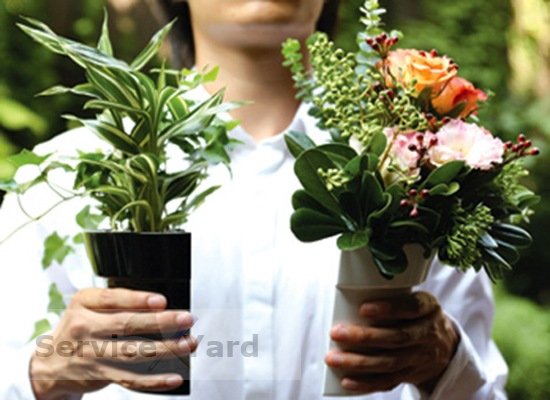How to deal with mold in flower pots?

Beautiful flowers on the windowsill give you a lot of positive emotions, but at one point, while admiring your wards, you found a whitish coating on the ground? This is the beginning of the development of mold in a flower pot. How to deal with mold in flower pots and prevent its further development, you will learn from this article.
to contents ↑Causes of mold in a flower pot
 The fungus, a common mold, begins to develop under favorable conditions for it. Disputes grow much faster in such situations:
The fungus, a common mold, begins to develop under favorable conditions for it. Disputes grow much faster in such situations:
- relative humidity above 95%;
- poor air ventilation in the room;
- low temperature in the room;
- clogged drainage system in the pot;
- overflow of a flower;
- heavy or acidic soil.
Very often, mold develops in the autumn, when the heating has not yet been switched on, it is chilly in the apartment, and it rains outside.
to contents ↑Important! If you notice that a fungus has begun to multiply on your flowers and you don’t know how to deal with mold in flower pots, do not delay the resolution of this important task and urgently proceed to destroy it! If this infection penetrates deep to the root of the plant, then soon it will simply die.
Signs of mold on plants
Surely, you know very well what the natural color of your plant is and what the soil in which it lives looks like. If you notice one of the following signs of the appearance of a fungus on your flower, then you should think about the question of how to deal with mold on plants.
These are:
- black fluff spots;
- gray threads of mold on the soil;
- powdery coating;
- crust;
- black dots;
- gray or rusty coating.
Important! Never present fresh flowers in a flowerpot to a person who is being treated in a hospital during donation. The patient's immunity is weakened, and the fungus is a very insidious infection - it is the causative agent of such diseases as:
- meningitis;
- bronchial disease;
- lung damage
- bladder disease.
to contents ↑And this is just the beginning of the list of what you can get when a fungal spore enters the human body!
What flowers are immune to mold?
Imagine that nature has protected some plant species from the fungus problem! If you do not want to take risks, you can get these flowers and not be afraid of the moldy enemy. These types include:
- ardizia;
- adenium;
- budra;
- caladium;
- patifitrum;
- neorigelia;
- siderasis;
- cyperus.
to contents ↑Important! Remember, more than anything, mold loves moisture and dirt. The cleaner and drier your home, the less bacteria and fungi live in your neighborhood. Keep clean and our tips will help you avoid unnecessary problems.
How to deal with mold on plants?
 There are many modern and folk ways that will help in the fight against mold on plants and in flower pots. We will be pleased to share some of them with you.
There are many modern and folk ways that will help in the fight against mold on plants and in flower pots. We will be pleased to share some of them with you.
Method 1
Mold develops foci. And at the same time its deceit is that you see on the surface of the earth only the “tip of the iceberg”. Not only does it grow in breadth, but also in depth! Once you find mold, you need to:
- Remove the topsoil with fungi.
- Add new land instead of deleted.
Important! By these actions you will not allow the introduction of the fungus into the root system of the flower, which could lead to its death.
Method 2
In this case, you will not only struggle with mold in flower pots, but at the same time feed your plant:
- Remove topsoil.
- Add humus and leafy soil.
- Add some new earth.
Thus, you remove the fungus, loosen and fertilize the soil.
Method 3
If you have expanded clay at your fingertips and you are ready to make efforts to remove the fungus from plants, proceed as follows:
- Remove the topsoil.
- Add new soil.
- Cover the earth with expanded clay from above.
This method will lead to the fact that a white coating will appear directly on the expanded clay. You will only need to collect and wash it as needed.
to contents ↑Important! Replacing the top layer of the earth works to temporarily suspend the development of the fungus. The most radical and effective method will be to remove all the soil and transplant the plant using new land.
Useful Tips:
- In autumn, when the microclimate at home changes and favorably affects the development of fungus on flowers, more often loosen the soil in flowerpots.
- Add crushed sphagnum and activated carbon tablets to fresh soil.
- Pour the ground with a solution of foundationazole (2g per 1 liter of water).
- The development and propagation of dormant fungal spores will help prevent lemon juice (1 teaspoon in a glass of water).
- Water your flowers with a solution of manganese 1-2 times every month.
Stock footage
Follow our tips and your flowers will delight you, your loved ones and friends with their beauty and health.
- How to choose a vacuum cleaner taking into account the characteristics of the house and coatings?
- What to look for when choosing a water delivery
- How to quickly create comfort at home - tips for housewives
- How to choose the perfect TV - useful tips
- What to look for when choosing blinds
- What should be running shoes?
- What useful things can you buy in a hardware store
- Iphone 11 pro max review
- Than iPhone is better than Android smartphones



